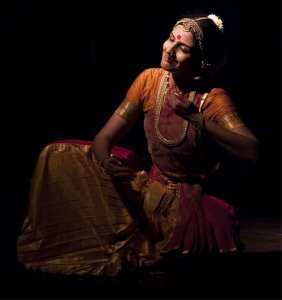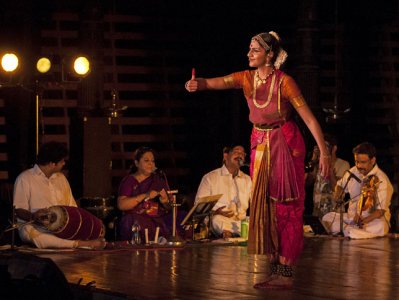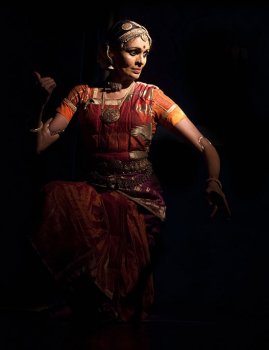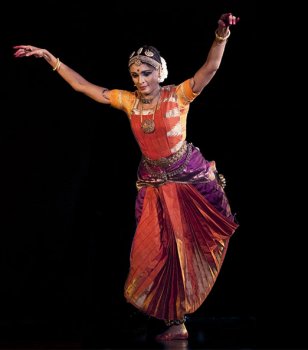
|   |

|   |
Soulful recitals at Soorya Fest - Text & pics: Rakesh Konni e-mail: rakeshkonni@gmail.com October 15, 2013 A talented new generation dancer and a follower of Vazhuvoor style of Bharatanatyam, Lavanya Ananth presented her recital at Vyloppilli Samskrithi Bhavan, Thiruvananthapuram, on the eighth day of the 37th Soorya Dance and Music Festival. Lavanya started her concert with an invocatory piece Amba Stuthi composed by percussionist MS Sukhi, set in ragamalika and adi. In this composition, she explored the concept of universal mother with the support of verses adapted from Lalita Sahasranamam and Raja Rajeswari Ashtakam. The movements and expressions of the dancer were adequate but this piece didnít give a lasting impact. 

Lavanya Ananth
Lavanya continued her performance into the pada varnam Swami ninne kori
nanura composed by Ponniah Pillai of the Thanjavur Quartet, set in
Ragamalika and roopaka talam. With her skills in abhinaya and nritta,
she portrayed the nayika requesting Lord Brihadeswara to come and accept
her. The jatis composed by MS Sukhi were not so elaborate, but was
enough to test the dancerís ability. Post varnam, Lavanya presented a
purely expressional item Jagadodharana, a popular devaranama composition
of Purandara Dasa, set in Kapi ragam and adi talam, where the beauty of
abhinaya was used to depict the wonder and astonishment the poet had
about mother Yasoda and infant Krishna. Then she moved on to another
abhinaya piece, a Kshetrayya padam Nanne Penladu in Ragamalika, where
she depicted a nayika who is after Krishna to marry him. The
choreography for this padam presented the nayika in three age groups.
Lavanya successfully captured the spectrum of expressions of mugda
nayika, madhya nayika and pragalbha nayika. She concluded her recital with a piece which celebrates the celestial light of Surya titled Bhaskaram with verses from Suryashtakam set in Ragamalika and Talamalika by MS Sukhi. With her excellent movements and usage of space, she made this composition a good supplement for thillana. Lavanya was supported by Neela Sukhanya Sreenivasan with few ups and downs on nattuvangam, Murali Parthasarathy with consistent singing, MS Sukhi on mridangam with some beautiful compositions and rhythm, and Kalaiarasan Ramanathan with a melodious violin. Acclaimed Bharatanatyam dancer and director of Kalakshetra, Priyadarsini Govind displayed her expertise at the same venue on the ninth day of the festival. With her graceful movements and controlled abhinaya and adavus, she proved once again that her aesthetic brilliance is at a different level. Priyadarsini virtually landed on the stage like an eagle. She opened her recital with an invocation to Narayana who rides on Garuda. The composition set in Ragamalika and Talamalika had its verses from Garuda Dhandakam by Vedanta Desika, with music by Rajkumar Bharathi. She sketched the dynamics of Garuda on stage with her amazing balance, controlled movements and stretches. She then moved on to the main item of the evening, a varnam Swami ninnu kori nanura, a composition of Ponnaiah Pillai of Thanjavur Quartet, set in Ragamalika and roopaka talam. In this composition the nayika expresses her love for Lord Brihadeswara of Thanjavur. Mridangam vidwan G Vijayaraghavan composed the jatis for this piece. With their vibrancy, the elaborate trikala jati and charana jati gave the dancer an opportunity to display her skill in adavus. With her equally fluent abhinaya for the lyrics, she made this varnam a perfect piece to showcase her mastery of the art. 

Priyadarsini
Govind
Priyadarsini continued her performance into two short abhinaya pieces
with contrasting emotions. Priya portrayed a khandita nayika in the
first padam Indendu Vachitivira set in Surutti and misra chapu. While in
this padam the nayika sarcastically reprimands her wayward lover, in
the javali that followed, the nayika is passionately in love and her
emotions spill out on seeing the hero. The javali Apudu manasu set in
Khamas raga and rupaka talam was composed by Patnam Subramanya Iyer.
Priyadarsini brilliantly portrayed the contrasting emotions. She
concluded her recital with a thillana composed by M Balamuralikrishna
and a nottuswaram of Muthuswami Dikshitar on Devi. She was able to keep
the energy level high and deliver a soulful final piece with a handful
of picturesque postures. On the downside, though Priyadarsiniís costume had some odd uniqueness, the vankis (many dancers donít wear armlets) she wore intermittently slid down her arms and she had to adjust it many times during the performance. On the support, the nattuvanar lost his timing for a while and the dancer had to prompt him to start the jati once during thillana. Despite the minor timing issue during the thillana, KS Balakrishnan was good on nattuvangam. The vocal support from Arun Gopinath was also commendable. The dancer was accompanied by Sakthivel Muruganandam on mridangam and N Sigamani on violin. A software engineer by profession, Rakesh Konni is a lover of classical dance forms and music. Writing and photography are his passions. |